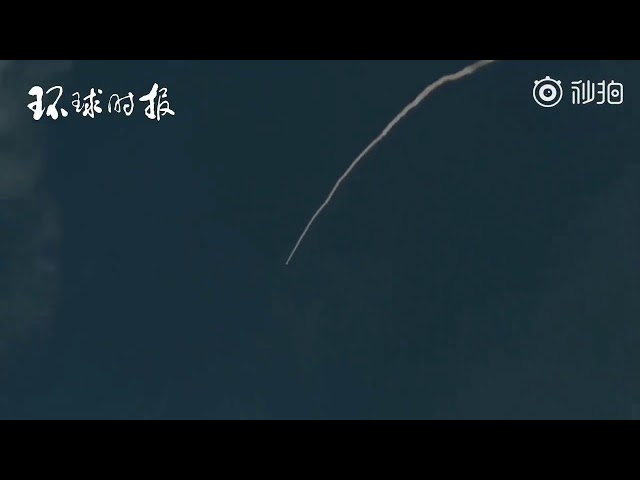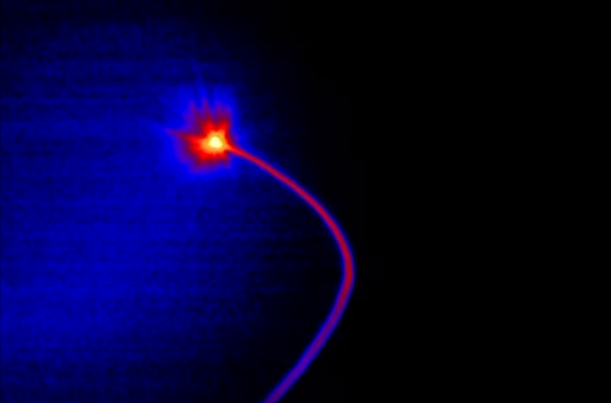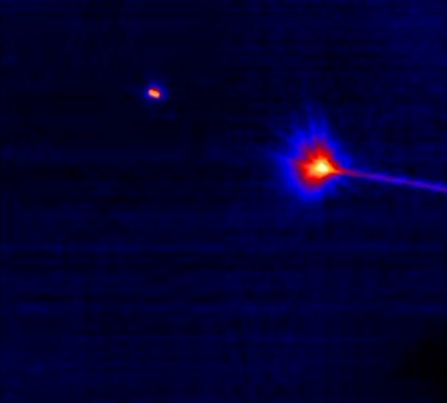How to install the app on iOS
Follow along with the video below to see how to install our site as a web app on your home screen.
Note: This feature may not be available in some browsers.
You are using an out of date browser. It may not display this or other websites correctly.
You should upgrade or use an alternative browser.
You should upgrade or use an alternative browser.
Out of the box ideas to penetrate modern bmds
- Thread starter Fawadqasim1
- Start date
Fawadqasim1
SENIOR MEMBER

- Joined
- Jan 24, 2017
- Messages
- 4,242
- Reaction score
- 1
- Country
- Location
Which works as fighters protecting their bomber
Just like in second world war p51 mustangs protected b17s
Just like in second world war p51 mustangs protected b17s
LeGenD
MODERATOR

- Joined
- Aug 28, 2006
- Messages
- 15,813
- Reaction score
- 162
- Country
- Location
Chaff countermeasures create additional set-of-targets to discriminate but they cannot fool high-resolution RCS measurements (chaff objects are not as big as the warhead and their structure is also not the same) and/or multi-spectral IR imaging techniques (chaff objects will produce thermal and/or micro-motion fluctuations which will be easy to distinguish from the thermal behavior of the warhead and filter accordingly).Velocity measurement can only work during terminal stage when rvs re enter the atmosphere and that is about 50km both of my ideas are against x band radar iir sensors. Xband stealth is a known technology used in fighters like f35 j31 and change in temp can if done intelligently
Can affect the iir sensor no matter what spectrum. Laws of physics are the limiting factors.
Their is also the issue of when to expend chaff in space. Chances are that the warhead is under lock already. In-fact, the activity of expending chaff will be a huge give-way in itself because the sensor architecture will pick on unusual activity and is unlikely to drop the prior lock on the warhead while at it.
Chaff countermeasures work in close-quarter engagements. Idea is to create a large cloud of objects and a chasing missile might crash into it.
Last edited:
Fawadqasim1
SENIOR MEMBER

- Joined
- Jan 24, 2017
- Messages
- 4,242
- Reaction score
- 1
- Country
- Location
High altitude means more boost phase energy which in turn means larger missileHigh altitude destinations to blind RADAR. Chaff and jammers.
Basel
ELITE MEMBER

- Joined
- Oct 31, 2013
- Messages
- 9,504
- Reaction score
- 2
- Country
- Location
1) X band stealth vehicle during midcourse
Phase.
2) thermal changes in the vehicle
during midcourse
Phase.
Please share your out of the box ideas.
@The Deterrent @LeGenD @BHarwana @Verve @Oscar @CriticalThought
@MastanKhan
Chinese wave rider vehicle is good concept to tackle BMD.
Basel
ELITE MEMBER

- Joined
- Oct 31, 2013
- Messages
- 9,504
- Reaction score
- 2
- Country
- Location
China tests its hypersonic
wave-rider aircraft
The successful test flight saw the Chinese wave-rider glide at more than five times the speed of sound
By ASIA TIMES STAFFAUGUST 6, 2018 3:52 PM (UTC+8)

China tested its first wave-rider prototype last week, which was mounted on top of a rocket and then traveled at Mach 5.5 on its own. Photos: Weibo
Chinese engineers say they have tested an aircraft based on sonic-wave-riding technology and able to carry multiple nuclear warheads, which theoretically could elude all anti-missile defense systems now in use worldwide.
China’s new aircraft is loosely based on the first wave-rider, the United States’ B-70 deep-penetration strategic bomber, or Valkyrie, which was grounded for good in the 1960s.
The six-engined, delta-wing US hypersonic aircraft was designed to cruise at Mach 3+ 21,000 meters above ground, meaning it was almost impossible to intercept using aircraft or missiles. However, the ill-fated Valkyrie made a wobbly start and a string of accidents and shifts in the US-Soviet Union arms rivalry led to the program’s cancellation.
Now a Chinese version of the nuclear-warhead-capable wave-rider aircraft, called Xingkong, or Starry Sky, has been developed by the China Academy of Aerospace Aerodynamics under the state-owned conglomerate China Aerospace Science and Technology Corp. It was tested last Friday from an undisclosed launch site in the wilderness of northwestern China.

Source: Global Times
During its maiden fight, the wedge-shaped Xingkong ascended to an altitude of 30 kilometers at Mach 5.5-6, or 7,344km/h, for more than 400 seconds in active phase, turning and making high-altitude maneuvers, according to the academy.
The academy also tested a host of cutting-edge technologies, such as a domestically developed heat-balance thermal protection system, various parameters were met and the wave-rider prototype was fully recovered, it added.
This type of aircraft uses the shock waves generated by its own flight as a lifting surface to enhance the lift-to-drag ratio to reach the hypersonic regime of Mach 5 or even above. Defense systems now in use by militaries around the world can only intercept incoming missiles flying at low speeds and whose trajectories are easy to predict.
The People’s Daily reported that the wave-rider gliding at such high speeds could “come and go at will” on a highly maneuverable trajectory, piercing through any anti-missile defense system in operation.
Chinese observers say any solid-propellant rocket has the potential to launch such a wave-rider, carrying both conventional and nuclear warheads, or a wave-rider can simply use its own immense kinetic energy to hit and destroy a target.
It was also reported that Russia was expected to deploy its Avangard hypersonic boost-glide vehicle mounted on the Sarmat heavy intercontinental ballistic missile by late 2018 or early 2019.
http://www.atimes.com/article/china-tests-its-hypersonic-wave-rider-aircraft/
wave-rider aircraft
The successful test flight saw the Chinese wave-rider glide at more than five times the speed of sound
By ASIA TIMES STAFFAUGUST 6, 2018 3:52 PM (UTC+8)

China tested its first wave-rider prototype last week, which was mounted on top of a rocket and then traveled at Mach 5.5 on its own. Photos: Weibo
Chinese engineers say they have tested an aircraft based on sonic-wave-riding technology and able to carry multiple nuclear warheads, which theoretically could elude all anti-missile defense systems now in use worldwide.
China’s new aircraft is loosely based on the first wave-rider, the United States’ B-70 deep-penetration strategic bomber, or Valkyrie, which was grounded for good in the 1960s.
The six-engined, delta-wing US hypersonic aircraft was designed to cruise at Mach 3+ 21,000 meters above ground, meaning it was almost impossible to intercept using aircraft or missiles. However, the ill-fated Valkyrie made a wobbly start and a string of accidents and shifts in the US-Soviet Union arms rivalry led to the program’s cancellation.
Now a Chinese version of the nuclear-warhead-capable wave-rider aircraft, called Xingkong, or Starry Sky, has been developed by the China Academy of Aerospace Aerodynamics under the state-owned conglomerate China Aerospace Science and Technology Corp. It was tested last Friday from an undisclosed launch site in the wilderness of northwestern China.

Source: Global Times
During its maiden fight, the wedge-shaped Xingkong ascended to an altitude of 30 kilometers at Mach 5.5-6, or 7,344km/h, for more than 400 seconds in active phase, turning and making high-altitude maneuvers, according to the academy.
The academy also tested a host of cutting-edge technologies, such as a domestically developed heat-balance thermal protection system, various parameters were met and the wave-rider prototype was fully recovered, it added.
This type of aircraft uses the shock waves generated by its own flight as a lifting surface to enhance the lift-to-drag ratio to reach the hypersonic regime of Mach 5 or even above. Defense systems now in use by militaries around the world can only intercept incoming missiles flying at low speeds and whose trajectories are easy to predict.
The People’s Daily reported that the wave-rider gliding at such high speeds could “come and go at will” on a highly maneuverable trajectory, piercing through any anti-missile defense system in operation.
Chinese observers say any solid-propellant rocket has the potential to launch such a wave-rider, carrying both conventional and nuclear warheads, or a wave-rider can simply use its own immense kinetic energy to hit and destroy a target.
It was also reported that Russia was expected to deploy its Avangard hypersonic boost-glide vehicle mounted on the Sarmat heavy intercontinental ballistic missile by late 2018 or early 2019.
http://www.atimes.com/article/china-tests-its-hypersonic-wave-rider-aircraft/
Fawadqasim1
SENIOR MEMBER

- Joined
- Jan 24, 2017
- Messages
- 4,242
- Reaction score
- 1
- Country
- Location
Our Chinese brothers @wanglaokan
Fawadqasim1
SENIOR MEMBER

- Joined
- Jan 24, 2017
- Messages
- 4,242
- Reaction score
- 1
- Country
- Location
come on guys use your GOD gifted intellect imagination vision.
LeGenD
MODERATOR

- Joined
- Aug 28, 2006
- Messages
- 15,813
- Reaction score
- 162
- Country
- Location
@Basel
Defeating an HGV, is challenging but possible.

Big wallet = numbers and experiments
Chaff is useful in close-quarters engagements.
Defeating an HGV, is challenging but possible.
Lasers?come on guys use your GOD gifted intellect imagination vision.

Big wallet = numbers and experiments
Nope.High altitude destinations to blind RADAR.
See my response to another member (post # 18)Chaff
Chaff is useful in close-quarters engagements.
Anti-jamming techniques.and jammers.
Last edited:
The Deterrent
SENIOR MEMBER

- Joined
- Jan 7, 2011
- Messages
- 3,168
- Reaction score
- 39
- Country
- Location
Symmetric Measures:
-Saturation (using decoys/MIRVs/brute numbers)
-MaRVs
-Hypersonic quasi-ballistic systems
-Radar jammers aboard RVs
Asymmetric Measures:
-High altitude nuclear blackout detonations
-SEAD ops using stealth aircrafts/cruise missiles/ARMs
-ASAT ops using ASAT missiles/lasers
-Saturation (using decoys/MIRVs/brute numbers)
-MaRVs
-Hypersonic quasi-ballistic systems
-Radar jammers aboard RVs
Asymmetric Measures:
-High altitude nuclear blackout detonations
-SEAD ops using stealth aircrafts/cruise missiles/ARMs
-ASAT ops using ASAT missiles/lasers
The Deterrent
SENIOR MEMBER

- Joined
- Jan 7, 2011
- Messages
- 3,168
- Reaction score
- 39
- Country
- Location
I can develop an auto pilot and linking system that cannot be jammed.

CriticalThought
SENIOR MEMBER

- Joined
- Oct 10, 2016
- Messages
- 7,094
- Reaction score
- 13
- Country
- Location
Sir this thread is not limited to Pakistan India context
Well... given the only nations that have nuclear missiles also are technologically advanced nations, their special forces could hand deliver nukes quite effectively.
I mean, the concepts of nuclear briefcase, nuclear artillery, and even nuclear gun, come from the cold war.
You are ignoring this method at your own peril. Remember, when EMP weapons have taken out electronics, war will be fought using good old fashioned iron sights. And when counter strikes demolish all factories, and no bullets are left, as well as no oil, it will be back to swords, arrows, and bricks.
LeGenD
MODERATOR

- Joined
- Aug 28, 2006
- Messages
- 15,813
- Reaction score
- 162
- Country
- Location
This is the animated view of a live-fire experiment (FTM-25) in which an Arleigh Burke class destroyer was subjected to a barrage of 2 x ASCM and 1 x SRBM:-

ASCM = Anti Ship Cruise Missile
SRBM = Short Range Ballistic Missile
ASCM performed impressive maneuvers to stress-test target acquisition and monitoring capabilities of the Aegis sensor suite. Aegis was able to identify, distinguish and track all targets in real-time, and produced a fire solution for each.
Arleigh Burke class destroyer neutralized all targets and went about its way.
---
Maneuvers of SM-2 interceptor in its effort to engage an MRBM-class RV (different test):-



Maneuvers of SM-6 interceptor in its effort to engage an ALCM (different test):-


NOTE: SM-6 interceptor(s) defeated an MaRV (Chinese DF-21D class) in a largely classified test (FTM-27 E2) in 2016.
FYI: https://nationalinterest.org/blog/t...ing-make-chinas-carrier-killer-missiles-18766
---
My sincere apologies to those who think that maneuverable cruise missiles*, MaRV and hypersonic quasi-ballistic missiles (including wave-rider glide types) will achieve anything if directed towards American warships.
Good luck at jamming an Aegis platform with an RV as well; sheer size, power, rugged and anti-jamming capabilities of the radar system will make this task impossible. Interceptors are also rugged and anti-jamming.
More importantly, advantages of Sensor Fusion and Cooperative Engagement Capability (CEC) are limitless for operations in EW environment. Arleigh Burke class destroyers can exchange information with each other much like F-22 Raptor and F-35 Lightning II. Onboard interceptors can also take cues from external sensor systems for target discrimination and acquisition, and negate the impact of jamming technologies in the process.
*Houthi rebels learned this fact the hard way: https://defence.pk/pdf/threads/uss-...ise-missiles-in-yemeni-waters-in-2016.543523/
The Arleigh Burke class destroyer is equipped with the Navy’s Aegis Combat System, the world’s foremost integrated naval weapon system which includes the AN/SPY-1D phased array radar, the most powerful air search radar in the Navy. The AN/SPY-1D radar scans in all directions simultaneously to detect, track and engage hundreds of aircraft and missiles. State-of-the-art C4I (Command, Control, Communications, Computers and Intelligence) systems provide the Arleigh Burke class destroyer crew with total situational awareness.
When integrated with the Aegis Combat System, the Cooperative Engagement Capability (CEC) permits groups of ships and aircraft to link their radars to provide a composite picture of the battle space, effectively increasing the theater space. The capability is designed to provide the Navy with a 21st Century fighting edge.
Source: https://ingalls.huntingtoningalls.com/our-products/ddg/
A Navy strike group has a variety of sensors to identify threats, including surface radars, sonar and airborne sensors, along with weapons systems that can engage a threat at various distances. CEC is the integration layer that moves data from the sensors to the appropriate weapon systems, creating what military strategists call an end-to-end, detect-control-engage capability.
"An individual sensor can't see everything," explains Vagle. "But if you have lots of sensors sharing the same data, you get a more accurate picture of the situation. That means a combat system can engage a target that it otherwise could not see, by using data from other sensors."
The real-time, composite network picture provided by CEC is also more resistant to electronic jamming.
Source: https://www.raytheon.com/news/feature/big-picture
---
CEC explained in great detail in this source: http://www.jhuapl.edu/techdigest/td/td1604/APLteam.pdf

ASCM = Anti Ship Cruise Missile
SRBM = Short Range Ballistic Missile
ASCM performed impressive maneuvers to stress-test target acquisition and monitoring capabilities of the Aegis sensor suite. Aegis was able to identify, distinguish and track all targets in real-time, and produced a fire solution for each.
Arleigh Burke class destroyer neutralized all targets and went about its way.
---
Maneuvers of SM-2 interceptor in its effort to engage an MRBM-class RV (different test):-



Maneuvers of SM-6 interceptor in its effort to engage an ALCM (different test):-


NOTE: SM-6 interceptor(s) defeated an MaRV (Chinese DF-21D class) in a largely classified test (FTM-27 E2) in 2016.
FYI: https://nationalinterest.org/blog/t...ing-make-chinas-carrier-killer-missiles-18766
---
My sincere apologies to those who think that maneuverable cruise missiles*, MaRV and hypersonic quasi-ballistic missiles (including wave-rider glide types) will achieve anything if directed towards American warships.

Good luck at jamming an Aegis platform with an RV as well; sheer size, power, rugged and anti-jamming capabilities of the radar system will make this task impossible. Interceptors are also rugged and anti-jamming.
More importantly, advantages of Sensor Fusion and Cooperative Engagement Capability (CEC) are limitless for operations in EW environment. Arleigh Burke class destroyers can exchange information with each other much like F-22 Raptor and F-35 Lightning II. Onboard interceptors can also take cues from external sensor systems for target discrimination and acquisition, and negate the impact of jamming technologies in the process.
*Houthi rebels learned this fact the hard way: https://defence.pk/pdf/threads/uss-...ise-missiles-in-yemeni-waters-in-2016.543523/
The Arleigh Burke class destroyer is equipped with the Navy’s Aegis Combat System, the world’s foremost integrated naval weapon system which includes the AN/SPY-1D phased array radar, the most powerful air search radar in the Navy. The AN/SPY-1D radar scans in all directions simultaneously to detect, track and engage hundreds of aircraft and missiles. State-of-the-art C4I (Command, Control, Communications, Computers and Intelligence) systems provide the Arleigh Burke class destroyer crew with total situational awareness.
When integrated with the Aegis Combat System, the Cooperative Engagement Capability (CEC) permits groups of ships and aircraft to link their radars to provide a composite picture of the battle space, effectively increasing the theater space. The capability is designed to provide the Navy with a 21st Century fighting edge.
Source: https://ingalls.huntingtoningalls.com/our-products/ddg/
A Navy strike group has a variety of sensors to identify threats, including surface radars, sonar and airborne sensors, along with weapons systems that can engage a threat at various distances. CEC is the integration layer that moves data from the sensors to the appropriate weapon systems, creating what military strategists call an end-to-end, detect-control-engage capability.
"An individual sensor can't see everything," explains Vagle. "But if you have lots of sensors sharing the same data, you get a more accurate picture of the situation. That means a combat system can engage a target that it otherwise could not see, by using data from other sensors."
The real-time, composite network picture provided by CEC is also more resistant to electronic jamming.
Source: https://www.raytheon.com/news/feature/big-picture
---
CEC explained in great detail in this source: http://www.jhuapl.edu/techdigest/td/td1604/APLteam.pdf
Last edited:
Similar threads
- Replies
- 5
- Views
- 313
- Replies
- 3
- Views
- 2K
- Replies
- 0
- Views
- 591
- Replies
- 0
- Views
- 127
- Replies
- 5
- Views
- 1K
Latest posts
-
-
-
Argentina Considering To Purchase 12 JF17C Worth 664Million Dollars
- Latest: FourMikeEcho
-
-
Pakistan Affairs Latest Posts
-
Pakistan military officer sues Adil Raja for defamation in unprecedented UK action
- Latest: muhammadhafeezmalik
-

